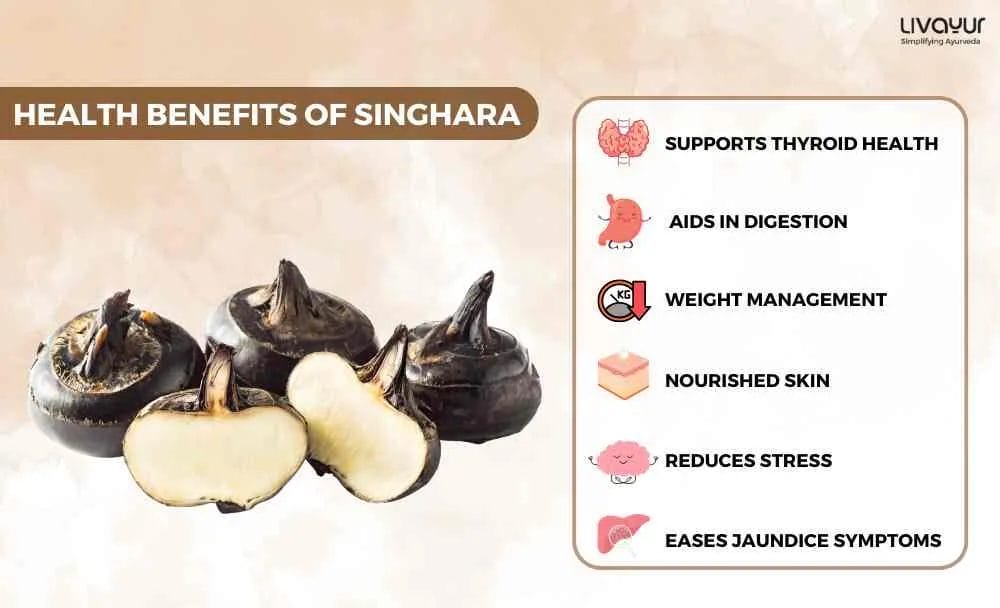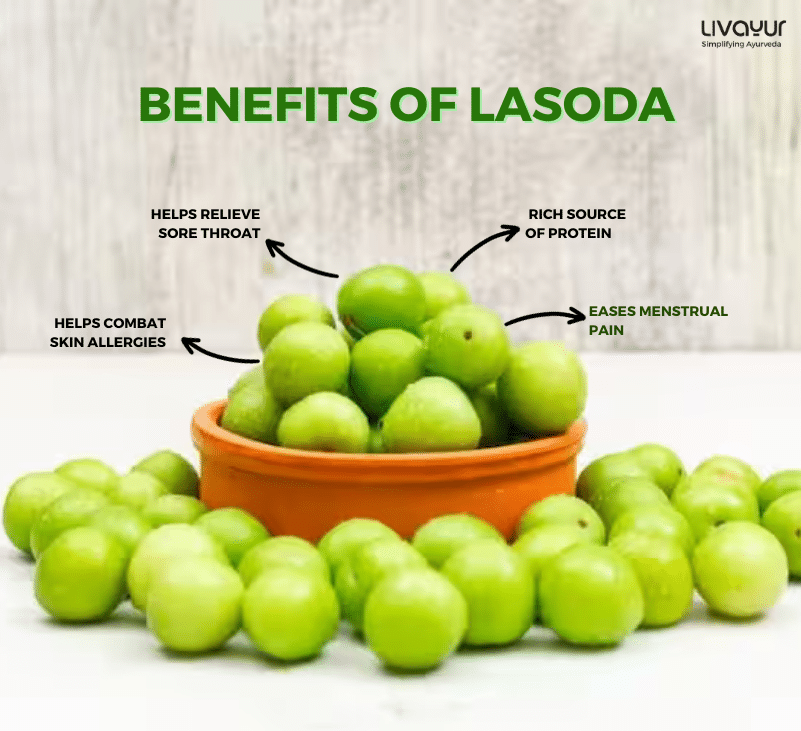
A healthy lifestyle (Vihar, in Ayurveda) is the pillar of holistic living. So, an individual can only achieve ‘Arogya’ or good health (in Ayurvedic terms) by consuming healthy foods. Today’s post brings lesser-known facts about one of the nutritious fruits that has been stable in Indian households for ages. Many people use the powdered or dried seeds as flour, while others consume it raw. Yes, you guessed it right – it’s none other than Singhara.
Wondering why Ayurveda considers it a necessary food in a regular diet? Let’s find out your answer in this post.
What is Singhara?
Water chestnut might be your favourite fruit, but chances are high that you don’t really know Singhara health benefits?
Eleocharis dulcis, as the botanical name indicates, is an aquatic fruit. Some people also call it a vegetable. In India, it’s known as Paniphal, Jalaphalam, Shingoda, etc.
Being a natural coolant, it’s rich in antioxidants. It’s starchy and contains a significant amount of fibre. Many Indian households use Singhara atta during fasting. The excellent health benefits of Singhara make it a must-include in your diet.
Nutritional Value of Singhara
The nutritional values provided for Singhara, also known as water chestnut, typically correspond to a standard serving size of 100 grams.
| Nutritional component | Value |
| Carbohydrates | 15.7g |
| Sodium | 14mg |
| Protein | 1.43g |
| Sugar | 2.86g |
| Fibre | 5.7g |
| Riboflavin | 0.02 mg |
| Potassium | 584 mg |
| Copper | 0.1 mg |
| Manganese | 0.4 mg |
| Vitamin B6 | 0.2 mg |
Singhara Properties in Ayurvedic Dictionary
Ayurveda embraces the benefits of Singhara significantly. Water chestnuts are considered fast food or ‘vrat’ for those who follow a regular diet on auspicious days. Besides, the natural coolant comes loaded with antioxidants that satisfy pitta and kapha doshas. So, someone suffering from acid reflux or inflammation can consume Singhara to improve the digestive system and promote health. (3)
Many Ayurvedic practitioners think the Singhara benefits go beyond digestive health and skin issues. In fact, it can also help combat infertility, painful urination, and fatigue, among others. Let’s find out some health benefits of water chestnut for certain health issues:
1. Supports Your Thyroid Health
Not to forget, for thyroid hormone production, your body needs two ingredients – iodine and thyroglobulin. Consuming Singhara maintains your thyroid hormones since it is rich in iodine. From supporting your thyroid health (2) to preventing hypothyroidism, it benefits your health.
2. Aids in Digestion
The fibre content in Singhara may reduce the risks of digestion-related diseases such as irritable bowel syndrome and constipation. It maintains your bowel movement. However, if you suffer from a crucial digestive disorder, it’s better to consult a medical professional first.
3. Reduces Skin Issues
The gallic acid in Singhara can alleviate skin-related issues. From reducing swelling to inflammation, Singhara can improve your skin conditions. Regular consumption hydrates your skin while leaving it with a radiant and youthful glow.
4. Weight Management
One of the significant benefits of Singhara is that it helps you with effective weight management. Singhara’s low-calorie content makes it beneficial for weight loss. You can consider it as a munchie for your snacks without worrying too much about consuming extra calories.
5. A Low-Calorie Food
Someone who follows a strict diet can include water chestnuts because of the low-calorie content while offering high nutrition. Did you know a hundred grams of singhara contains ninety-seven percent calories and negligible fat? Besides, the rich content of fibre, manganese, potassium, and other nutrients make it a comfort food option for someone struggling with weight management.
6. Reduce Stress
An unhealthy diet and a modern lifestyle (besides other parameters) may result in hypertension. With Singhara included in your regular diet, you no longer have to worry. Water chestnuts can combat oxidative stress since they have a high antioxidant content.
7. Eases Jaundice Symptoms
Singhara has detoxifying properties and antioxidants. So, it’s beneficial for those suffering from jaundice symptoms. What it does is aid liver function and promote detoxification. That’s how it alleviates jaundice symptoms.
How to Use Singhara?
Now that you have discovered the benefits of Singhara, it’s time to understand its usage. So, how do you use it? Let’s find out:
- Boil seeds and remove the skin before eating
- Consume raw seeds
- Turn the dried and grounded seeds into a powder and use it as atta or flour
- Singhara atta paste soothes cracked heels
- Consuming Singhara with milk improves libido in men and prevents miscarriages
You can take an Ayurvedic practitioner’s advice before consuming Singhara.
Are There Any Potential Side Effects of Singhara?
Water chestnuts contain high fibre. So, overconsuming might result in stomach aches. Suddenly increasing the fibre content in your diet can also cause gas and pain. So, it’s imperative to stick to a moderate amount.
A Few Quick Notes: Pregnant and breastfeeding ladies should get in touch with a medical expert before consuming Singhara. Older adults should avoid overconsuming the fruit to avoid stomach issues. Children must consume Singhara only under the guidance of an Ayurvedic doctor or their parents.
Conclusion
So, adding Singhara to your diet can help improve your health in many ways. Despite the multiple Singhara benefits, overconsumption can result in serious consequences. So, get advice from an Ayurvedic professional to understand how much Singhara is best for you.
FAQs on Singhara
1. Can I use Singhara for weight loss?
One of the Singhara health benefits is that it can help you manage weight loss because of the high antioxidant content. (1)
2. Can I consume Singhara during pregnancy?
Singhara is only advised for consumption after delivery to check the woman’s haemorrhage. It’s best to get advice from healthcare experts for breastfeeding women.
3. What are the side effects of Singhara?
Consuming more than the necessary amount of Singhara can trouble your digestive health. It may result in stomach pain and aches.
4. How much Singhara is safe to consume?
It’s best to consume a hundred grams of water chestnut. Overconsumption may result in reactions and digestive issues.
5. Can we eat Singhara daily?
Someone who loves fruits can consume Singhara daily. However, you must be careful about the amount of overuse as it can be dangerous for your health.
6. Can we eat raw Singhara?
Of course, you can eat raw Singhara. Otherwise, someone who does not like the raw flavor can boil or make a pickle.
References
- One of the Singhara health benefits is that it can help you manage weight loss because of the high antioxidant content. (rescon.jssuni.edu.in)
- Singhara Supports Your Thyroid Health (www.mdpi.com)
- Someone suffering from acid reflux or inflammation can consume Singhara to improve the digestive system and promote health. (nopr.niscpr.res.in)




















